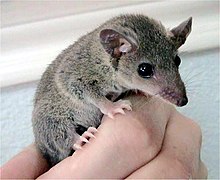Gray short-tailed opossum
| Gray short-tailed opossum | |
|---|---|
 |
|
| Scientific classification | |
| Kingdom: | Animalia |
| Phylum: | Chordata |
| Class: | Mammalia |
| Order: | Didelphimorphia |
| Family: | Didelphidae |
| Subfamily: | Didelphinae |
| Genus: | Monodelphis |
| Species: | M. domestica |
| Binomial name | |
|
Monodelphis domestica (Wagner, 1842) |
|
 |
|
| Gray short-tailed opossum range | |
| Synonyms | |
|
Monodelphis domesticus |
|
Monodelphis domesticus
The gray short-tailed opossum (Monodelphis domestica) is a small South American member of the Didelphidae family of opossums. It was the first marsupial to have its genome sequenced. The opossum is used as a research model in science, and is also frequently found in the exotic pet trade. It is also known as the Brazilian opossum, rainforest opossum and in a research setting the laboratory opossum.
Gray short-tailed opossums are relatively small animals, with a superficial resemblance to voles. In the wild they have head-body length of 12 to 18 cm (4.7 to 7.1 in) and weigh 58 to 95 grams (2.0 to 3.4 oz); males are larger than females. However, individuals kept in captivity are typically much larger, with males weighing up to 150 grams (5.3 oz). As the common name implies, the tail is proportionately shorter than in some other opossum species, ranging from 5 to 9 centimetres (2.0 to 3.5 in).
The fur is greyish brown over almost the entire body, although fading to a paler shade on the underparts, and with near-white fur on the feet. Only the base of the tail has fur, the remainder being almost entirely hairless. The claws are well-developed and curved in shape, and the paws have small pads marked with fine dermal ridges. Unlike many other marsupials, females do not have a pouch. They typically possess thirteen teats, which can be retracted into the body by muscles at their base.
The gray short-tailed opossum is found generally south of the Amazon River, in southern, central, and western Brazil. It is also found in eastern Bolivia, northern Paraguay, and in Formosa Province in northern Argentina. It inhabits rainforest environments, scrubland, and agricultural land, and often enters man-made structures, such as houses. There are no recognised subspecies.
...
Wikipedia

